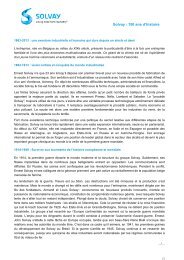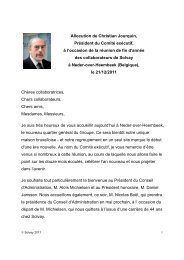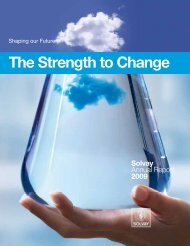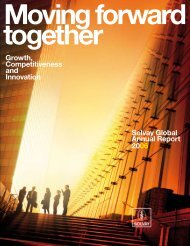solvay_live243_p02a04 somEdito
solvay_live243_p02a04 somEdito
solvay_live243_p02a04 somEdito
You also want an ePaper? Increase the reach of your titles
YUMPU automatically turns print PDFs into web optimized ePapers that Google loves.
Dossier SolvayInnovationTrophy2006<br />
70<br />
Like many other companies, Air Liquide has undertaken<br />
a systematic cost reduction exercise. It now wants<br />
to move beyond this with an efficiency and growth<br />
system which draws its strength from human resources<br />
and from knowledge-sharing. Its name is OPAL, short<br />
for Operating Practices at Air Liquide.<br />
Air Liquide<br />
shares good practices<br />
OPAL didn’t happen just like that. First of all it was felt<br />
that successive competitiveness plans had gone as<br />
far as they could. Second, Air Liquide’s geographic<br />
expansion was placing it – despite its world leadership<br />
in its market – in a challenger position in new<br />
and highly competitive territories. All at once this was creating a<br />
huge demand for transfer of knowledge. But whilst new countries<br />
were hungry for knowledge, mature countries poorly understood<br />
the need to share theirs. Finally, and logically enough, customers<br />
were calling for more standardized procedures to guarantee identical<br />
products across the world. Two years ago Air Liquide drew the<br />
conclusion that it had to do things differently, and better. The<br />
response was to initiate a discussion of good – and generally innovative<br />
– practices and how best to transfer them.<br />
From good practices to best practices<br />
The OPAL philosophy can be summarized in four words: gather,<br />
structure, share, implement.<br />
This does not bridle innovation on the ground, which is vital<br />
for creating and maintaining dynamism, but it standardizes<br />
the way it is put into practice and makes it more accessible within<br />
the group’s strongly decentralized culture. A five-stage approach<br />
was introduced:<br />
• international benchmarking to identify good practices;<br />
• structuring practices so they can be communicated and<br />
exchanged horizontally, between entities and between product<br />
lines;<br />
• implementation;<br />
• measuring, consolidating and analysing the results;<br />
• permanent appropriation by entities in a natural and autonomous<br />
fashion.<br />
The project’s success is due to the top management attention<br />
focused on it. A specific investment budget was earmarked for the<br />
purpose. A dedicated 5-person team travels to provide effective<br />
on-site support. Two-monthly reports are submitted to a delegation<br />
of the Executive Committee (Comex). Each country appoints<br />
its own OPAL leader and horizontal ‘communities of practice’<br />
segment the approach into topics: procurement, human resources,<br />
legal, sales etc. In addition, good local practices and recommendations<br />
can become best practices by Comex validating them as<br />
mandatory procedures for the entire group.<br />
“Airliquidized” innovation<br />
Nothing particularly new in all that? Don’t be so sure of it. The<br />
progress lies in the process of collecting, formatting and converting<br />
the various stimuli and impetuses from the grass roots into continuous<br />
improvement of results. This is a never-ending process,<br />
with the underlying system designed to be self-maintaining. A series<br />
of tools – free-of-charge as are the services of the dedicated project


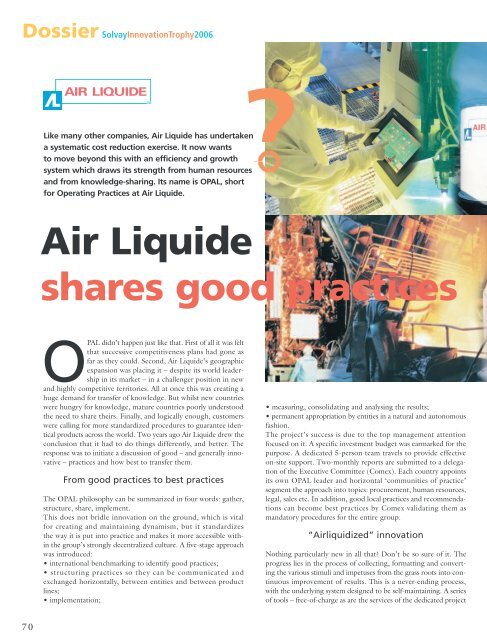

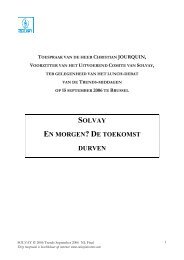
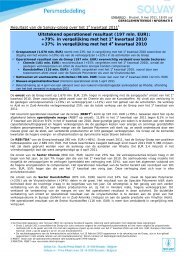

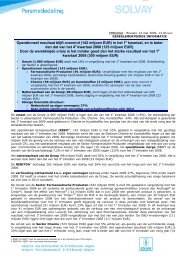
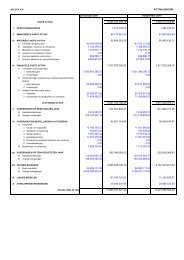

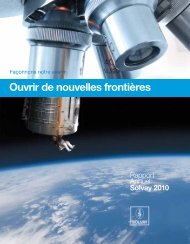
![PROC.1 [LETTRE] - Solvay](https://img.yumpu.com/16585746/1/184x260/proc1-lettre-solvay.jpg?quality=85)
